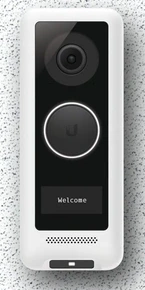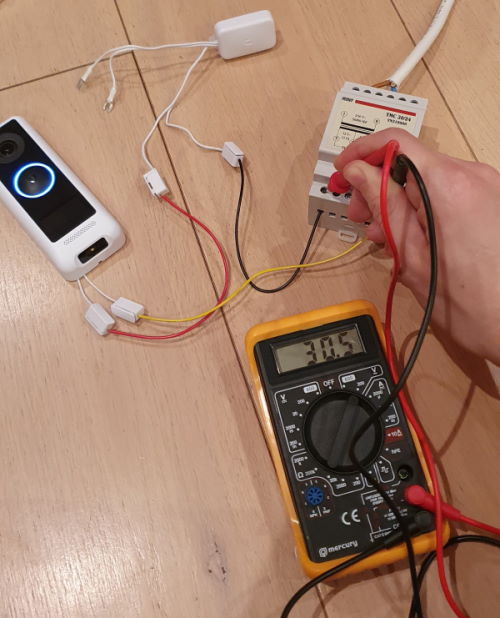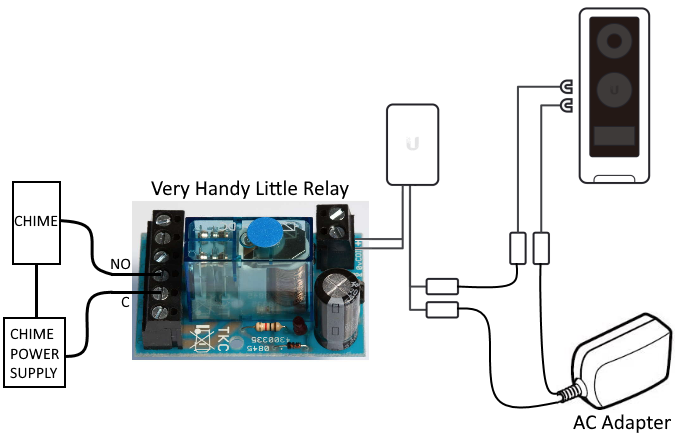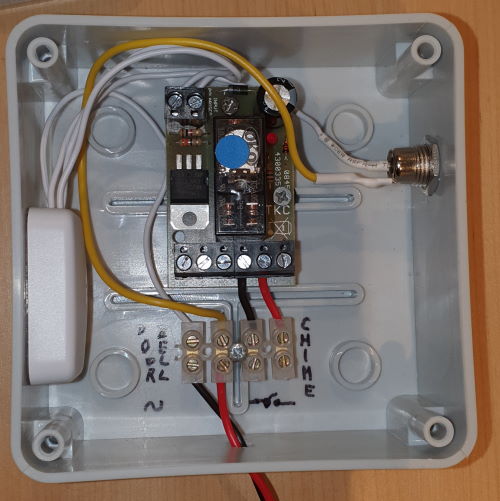Having previously invested in a UniFi Protect surveillance infrastructure, I recently bought a UniFi G4 Doorbell from the States. In the pursuit of a proper set-up, I did a lot of googling and found a lot of information, some of which brilliant, some useful, and some outright wrong. This post is meant as recap of my findings.
Introduction

The UniFi G4 Doorbell is a brilliant piece of kit, well-integrated with the UniFi Protect video surveillance infrastructure. The platform allows you to store data locally, without a subscription and without the creepiness that comes with Ring. The lack of a cloud-based infrastructure, however, is a double-edged sword: you can’t run the doorbell stand-alone without a recording device.
Like many smart doorbells, it connects to the network via WiFi, but takes power from an existing wired doorbell circuit. It is intended to be a drop-in replacement for a doorbell with chime, which in the US normally run on 16V AC power. In Europe most doorbell circuits run on 8V AC power, which means that we need to do some electrical wizardry to get it to work.
Most articles that talk about smart doorbells for European applications use the Honeywell Ding Dong 8-16V Chime, and there don’t seem to be many 16V alternatives on the European market. My goal for this project was to achieve the widest compatibility with chimes, especially European 8V ones.
Credits
My main inspiration was this article on lazyadmin.nl. I invite you to read it, especially the instructions to assemble the doorbell and install it on a door. This is where I got the idea of using a relay to decouple the higher-voltage doorbell power circuit from the lower-voltage chime circuit.
This article is also useful, even though it applies to the Nest Hello.
My uncle Giovanni, who is an Electronics Engineer, has reviewed and corrected the bit about power adapters.
How to choose a power adapter
The data sheet says the doorbell needs 16-24VAC, and has 12VA max power consumption. VA stands for volt-amperes, and it is a way to express apparent power in AC circuits.
Many adapters state their power in Amperes, so to understand what AC adapter to use, you need to look at the output voltage of the adapter, and divide the Volt-Amp value by the output voltage. It’s simple maths.
So, for example, if you have a 16V adapter, you will need at least
\[\frac{12 \bcancel{V} A}{16\bcancel{V}} = 0.75A\]This is just a reasonable estimate. In reality things are a bit more complex and from the electronics point of view, you’re probably likely to need less than that1.
Ubiquiti’s own Power Supply is 20V, 0.7A, so
\[20V \cdot 0.7A = 14VA\]So, 14VA is plenty.
The lazyadmin.nl article I mentioned earlier uses a 24V/30VA Vemer VN319000 adapter. But when I ran the Ubiquiti doorbell with it, it output 30.5V.

Vemer’s technical assistance team has confirmed that this is within tolerance of the VN319000. They said that with an unregulated adapter - and most of the adapters you normally buy will be unregulated - if your load is lower than the maximum load, then the output voltage may be higher than its rated output voltage. I honestly don’t know if this tolerance margin justifies the Vemer adapter being so far off its rated 24V, but nevertheless I decided not to use a device whose output is outside the Ubiquiti specification.
Also, many articles online say that the transformer you use should be powerful enough to power both the doorbell and the chime at the same time. In reality, when you press the button on the UniFi Doorbell, the doorbell temporarily shuts its internal power and gives all the power to the chime. This means that at any given time, you’re powering either the chime, or the doorbell, but never both. Ubiquiti support has confirmed that this is exactly how it’s meant to operate.
Morale of the story: you need an adapter rated about 12-14VA, and not much more than that.
Enough talking. How do I do this?
The lazyadmin.nl article uses a 24V AC adapter and a 24V relay. Because I wanted to use a lower-power adapter, I also had to find a different relay. Most unregulated AC adapters have a tolerance of ±10%, so it is best to choose an adapter whose tolerance will fall completely between Ubiquiti’s rated voltages.
I bought:
- A 18V 0.8A AC-AC adapter from AC Adaptors R Us Ltd. Very solid product, runs cool, and outputs 14.4VA. 18V±10% is 16.2-19.8V, which is perfectly within Ubiquiti’s range of 16 to 24V.
- A Very Handy Little Relay. This relay takes any input voltage between 6 and 28V, DC or AC.
I then connected everything like this:

Note: the NO/C (Normally Open / Common) connectors of the Very Handy Little Relay will behave exactly like your old doorbell button. As such, you can connect anything to them: a battery-powered chime, a chime with an external power supply, etc… If you have an existing doorbell circuit, you can connect it to those two contacts.
In my setup, I bought a DC connector compatible with the above AC adapter, put everything in a suitable plastic box and combined everything with a terminal block. A bit of soldering here and there, and here is the result:

And here it is, in operation. Voltage reading at the doorbell is 19.3V. Since I haven’t yet found a chime I like yet, in the video I am using the multimeter as a chime.
Other adapters I tried
This post was the result of much trial and error. Here is a list of other adapters I tried and why they didn’t work for me.
| Adapter | Why it didn’t work |
|---|---|
| This and this other adapter | Both adapters were the same model. They were powerful enough, but they ran very hot and emanated a very chemical, burning-plastic smell. |
| Vemer VN319000 30VA AC Adapter | As mentioned above, it was too powerful and output 30.5V. |
| Vemer VN317400 15VA AC Adapter | Even though it’s rated at 15VA, which would make it theoretically perfect for this application, it still output 31V! |
| PROTEK 16V 8VA BT8-16 AC Adapter | One of my initial attempts. Would power up the doorbell, but since it’s rated 8VA it’s probably too weak. |
Footnotes
-
A reasonable assumption is that the circuitry inside the doorbell requires DC current at a fixed voltage. To achieve that, the doorbell circuitry probably incorporates a voltage regulator and an AC-DC converter. Voltage regulators work by dissipating some energy to bring the output voltage down to the necessary fixed level, so the higher the input voltage, the more energy they need to dissipate to reach the desired level. As such, the point of maximum current draw of the device will be towards the high end of its voltage range, and its current requirements will drop as you feed it with lower voltages. Taking all of this into account, Ubiquiti says that its “max power consumption” is 12VA, so this is likely to be at 24V. As such, it may be that at 16V the doorbell actually uses 11VA or even less. Without knowing more about the internals of the doorbell, it is difficult to say. ↩